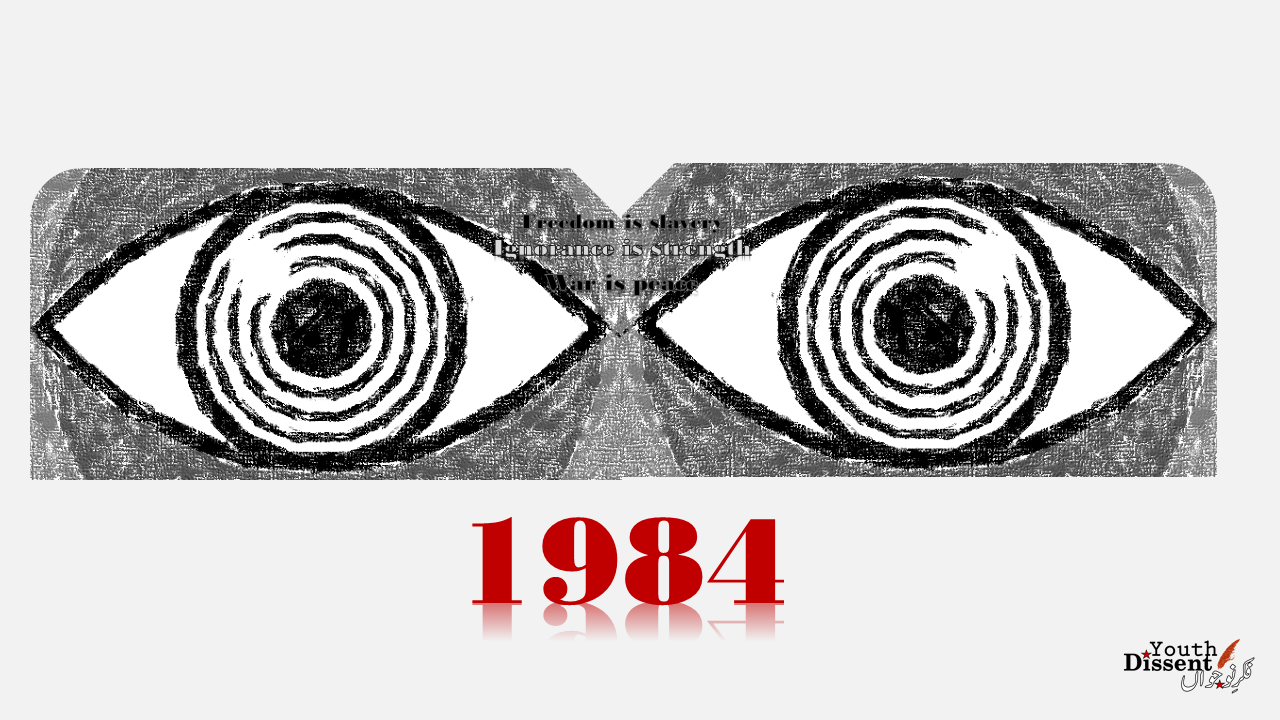Book Review of George Orwell’s “1984” By Asad Juttah
Orwell was a man whose scathing views of social inequality, injustice and totalitarianism reflected through his works of exquisite writing. A social commentary, and exemplary example of dystopian fiction, George Orwell’s “1984” forces one to think about the danger associated with giving any one person or entity too much power or control over our lives-issues. The novel is set in Great Britain, a province of the superstate Oceania, whose residents are victims of perpetual war, omnipresent government surveillance and public manipulation.
The story takes place in an imagined future, the year 1984, when much of the world has fallen victim to perpetual war, omnipresent government surveillance, historical negationism, and propaganda. Great Britain, known as Airstrip One, has become a province of a totalitarian superstate named Oceania that is ruled by the Party who employ the Thought Police to persecute individuality and independent thinking. Big Brother, the leader of the Party, enjoys an intense cult of personality despite the fact that he may not exist. The protagonist, Winston Smith, is a diligent and skillful rank-and-file worker and Party member who secretly hates the Party and dreams of rebellion. He enters a forbidden relationship with a co-worker, Julia.
Everyone is always being watched, heard, followed and oppressed by The Party in the rule of dictator Big Brother. The life of every human being is narrowed down to proving the doctrine of a single ruler. And there is no way out. Nothing to oppose them or derail them. History gets re written every minute, every hour and every day.
This book is dark, intense and extremely realistic about the nothingness of the present. The world we perceive is as perceived by the powerful, as controlled by the party, as fuelled by the fascists. We know the truth, but the truth has been subjected to a complex stress by the powerful that we have made the truth so vulnerable and has ended up fighting for what has never been the truth. We have been upholding the fictional fabric of lies that has been very methodically and technically crafted in front of our eyes.
The novel which was written in 1949, totally elaborate the policies of totalitarian governments in this era. Fascist governments have occupied the minds of the people in the name of mass media; state narrative has been dominated on freedom of speech, people have been kept ignorant and thinking has been made a crime and those who dissent are vaporised.
It does seem like we are living now in the exact scenario in Pakistan and it can be related to every part of the world.
Why George Orwell wrote this novel
Unlike many dystopian novels, which are set in distant and unfamiliar futures, 1984 is convincing in part because its dystopian elements are almost entirely things that have already happened, as Orwell drew from first-hand experience in creating the world of Oceania. For example, “2 + 2 = 5” was a real political slogan from the Soviet Union, a promise to complete the industrializing Five-Year Plan in four years. Orwell satirizes the slogan here to demonstrate the authoritarian tendency to suspending reality. Prior to writing the novel, Orwell had watched the communist revolution in Russia and volunteered to fight against the Fascist government in the Spanish Civil War. At first supportive of the Russian Revolution, Orwell changed his opinions after realizing that behind the veneer of justice and equality lurked widespread famines, forced labor, internal power struggles, and political repression. While fighting in the Spanish Civil War, Orwell became disillusioned with elements within the resistance forces that he felt wanted to replace the Fascist government with an authoritarian regime of its own. These experiences provide much of the political satire of 1984.
The Spanish Civil War catalyzed Orwell and made him highly critical of authoritarian tendencies on the left. Much of the Party’s brutality, paranoia, and betrayals are drawn from the Great Purges of 1936–1938 in the Soviet Union. Over 600,000 people died in an official purge of the Communist Party, in an era that also included widespread repression of the public, police surveillance and execution without trial, and an atmosphere of fear. In 1984, Goldstein is the stand-in for Leon Trotsky, the revolutionary figurehead who Stalin cast out of the party and denounced as a traitor to the cause. Jones, Aaronson, and Rutherford symbolize people who were executed or sent to forced-labor camps. Trotsky’s manifesto, The Revolution Betrayed, has much in common with Goldstein’s book, from the tone of writing to the subjects discussed. The rise of Hitler and the scapegoating of Jews and other “undesirables” also had a profound effect on Orwell. He realized that mass media was a key factor in Hitler’s rise, enabling prominent figures and organizations to shape public opinion on a broad scale. The intrusive telescreens and the Party’s frequent parades and events are drawn from Nazi Party public propaganda and its marches and rallies.
When 1984 was written, World War II had ended only a few years prior, and many people believed a World War III was inevitable, making the wars of the novel feel not just realistic but unavoidable. Additionally, 1984 was written three years after the U.S. dropped atomic bombs on Hiroshima and Nagasaki, and Orwell references nuclear-powered wars happening in different parts of the world. The idea of three superstates came from the 1943 Tehran Conference, where Stalin, Winston Churchill, and Franklin D. Roosevelt discussed global “areas of influence” and how they should exercise their influence on the rest of the world. Orwell also included everyday life experiences from World War II London. The unappetizing food, inconsistent electricity, and scarcity of basic household goods in 1984 come from Orwell’s experiences with wartime rationing. Frequent bombing raids on London appear in 1984 as well, an echo of the Blitz campaign carried out by Germany on London and the surrounding areas, in which 40,000 people died and almost a million buildings weredestroyed.



